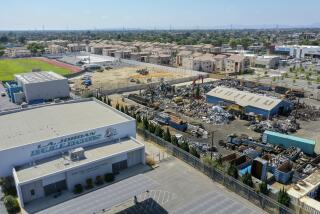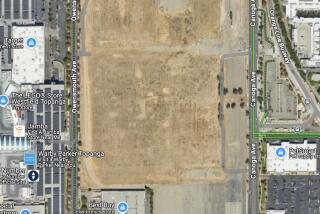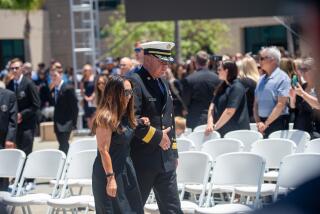Rocketdyne Promises to Stiffen Safeguards : Inquiry: Company says static electricity, spark or hot pan may have ignited container of explosives in fatal blast.
Promising tighter safety controls after an explosion at their Santa Susana Field Laboratory, Rocketdyne officials said Tuesday they believe two test engineers died and a third was injured because something ignited the small, half-full container of explosives one worker was carrying.
Static electricity, a spark or a hot pan from an earlier test-burn could have touched off the highly volatile nitrocellulose the unidentified worker had been holding, said Rocketdyne President Paul Smith. But he added, âI really donât want to speculate on what caused this explosion.â
Although the theory is not conclusive, it was as close as a three-week internal investigation could come to the cause of a July 26 blast at the facility.
Meanwhile, the California office of the Occupational Safety and Health Administration is continuing its own investigation of the explosion that killed Otto K. Heiney, 53, of Canoga Park and Larry A. Pugh, 51, of Thousand Oaks, and injured Lee Wells, 62, of Newbury Park.
It will be two to four weeks before the state safety agency decides whether to cite Rocketdyne for any safety violations, said Rick Rice, a Cal/OSHA spokesman.
Citing the privacy of the victimsâ families, Smith refused to say at a news conference at Rocketdyneâs Canoga Park headquarters whether it was Pugh or Heiney who carried the 6-by-6 1/2-inch plastic container of nitrocellulose that Rocketdyne investigators say they believe exploded.
âIn this business weâre in--and in fact in any business--accidents shouldnât happen,â Smith told reporters. âThis accident has only heightened our belief that we canât pay too much attention to safety.â
From now on, Rocketdyne health and safety inspectors will scrutinize safety procedures in every test involving high-energy chemicals beforehand, he said.
And until fail-safe test methods are in place, Rocketdyne has suspended tests involving nitrocellulose and glycidal azide polymer, the rocket fuel ingredient that was being tested on July 26, Smith said.
âToo often, people get comfortableâ in laboratory work, Smith said. Safeguards must be in place âno matter how comfortable the employees are,â he said.
Smith and Michael McHale, Rocketdyneâs vice president of advanced programs, said this is what their investigation found:
The workers had laid out one aluminum test pan that morning, surrounding it with a square, bottomless, 2-foot-high box-like shield made of 3/8-inch-thick aluminum sheet.
Then they covered the pan with a layer of sawdust and spread about three or four pounds of nitrocellulose atop that, capping the mixture with three to four pounds of glycidal azide polymer.
One worker assigned to ignite the mixture inserted an electrical device known as a âmatchâ into the mixture. He alone carried a key to switch the device on, so the chemicals could not be sparked accidentally while other workers were nearby, Smith said.
*
Then that worker and his four colleagues retreated to the safety of a nearby block house. There, he used the key to trigger the match, which heated in microseconds to about 450 degrees Fahrenheit and set the sawdust and chemicals afire.
A brief, intense fireball about 15 to 20 feet across bloomed out of the top of the shield enclosure while acoustic probes nearby recorded the shock waves.
Workers noticed some flames lingering in the residue afterward, indicating not all the chemicals had burned. But they dumped dirt and water into the pan, then shoved it toward the northern end of the test enclosure and set up another shield and pan directly to the south of the first one.
After laying chemicals out in the southern pan, the workers retreated to the blockhouse and ignited them, causing another fire.
âIt went normally, and at this point they returned to the area,â dumped dirt into the southern test pan and cleaned out the northern test pan, Smith said.
âThere was no question it had cooled off,â he said. âThey put in the sawdust, they put in the chemicals and started to withdraw from the area.â
Then the workers saw either Pugh or Heiney--Rocketdyne declines to say which--walk to a storage area and retrieve an open, five-pound plastic container of nitrocellulose.
Surviving test workers told investigators the container seemed to hold about two pounds of the material, a highly volatile nitrated wood pulp. Nitrocellulose is used in testing to accelerate the burning of other chemicals, said Rocketdyne spokesman Paul Sewell.
The inch-thick layer of nitrocellulose spread out on the test pan could never explode, but several inches of it in the plastic container could, said McHale.
As the worker carried the container back toward the test pans, his co-workers âwere all looking at other things, and none of them saw what happened to that container of nitrocellulose,â Smith said.
Then came the blast.
It blew apart the southern test shield--which had held only residue from the second test--splitting its seams and flinging the aluminum shield walls in all directions. The explosion also threw the northern shield against a hillside some 50 feet away.
*
Ventura County coronerâs officials said the blast killed Pugh and Heiney instantly.
It also caused severe burns to the arms of Lee Wells, the only one of the other three employees at the site who has been identified by Rocketdyne.
In an interview, Wells said his memories of the moments before the blast were âpretty doggone foggy.â
âAll I could remember was I was over at the sidelines and I felt the impact, and I was on the ground,â Wells said. âI didnât watch them put the stuff in to any degree. . . . All I felt was the big rush, and that was it.â
Blast Theory Twice that day, Rocketdyne employees had laid out chemicals in aluminum pans surrounded by square shields of 2-foot-high, 3/8-inch thick sheet aluminum. Then they had retreated to the blockhouse,ignited the chemicals remotely and recorded the resulting fire with acoustic probes.After two successful tests, workers cleaned out the northern pan and filled it with chemicals for a third test. As heiney or Pugh walked toward the area carrying a small container of nitrocellulose, something ignited the chemical and triggered the explosion. The blast blew apart the southern shield and flung the northern shield against a hillside 50 feet away. 1. Otto K. Helney, an engineer, was killed. Responsible for the pans housing the chemicals, he was only about two feet away from the explosion. 2. Larry A. Pugh, a physicist, was about six feet away and was killed instantly. 3. Lee Wells, on site to assist, was farther away and blown against hills behind test site, suffering second-and third-degree burns on 20% of his body. 4. Site manager / chemist, farther away, escaped without injury. 5. Engineer, also unharmed. Source: Rockwell Internationalâs Rocketdyne division.
More to Read
Sign up for Essential California
The most important California stories and recommendations in your inbox every morning.
You may occasionally receive promotional content from the Los Angeles Times.










